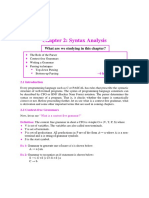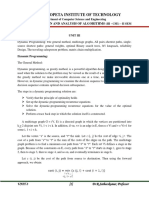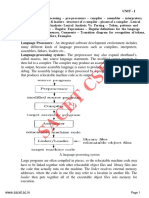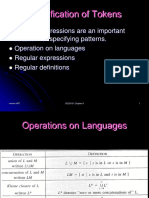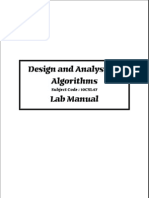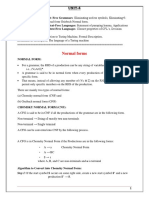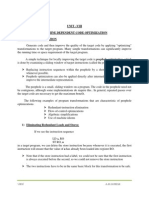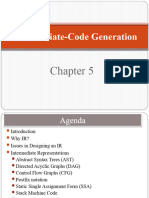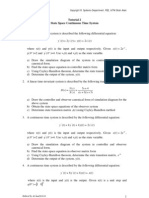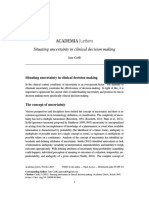BCSE307L_COMPILER DESIGN
Dr. B.V. Baiju,
INTERMEDIATE CODE SCOPE,Assistant Professor
GENERATION VIT, Vellore
INTERMEDIATE CODE GENERATION
• Intermediate code can translate the source program into the machine program.
• Intermediate code is generated because the compiler can’t generate machine code
directly in one pass.
• First, it converts the source program into intermediate code, which performs efficient
generation of machine code further.
• Intermediate code generator receives input from its predecessor phase and semantic
analyzer phase. It takes input in the form of an annotated syntax tree.
• The intermediate code can be represented in the form of
– Postfix notation
– Syntax tree
– Directed acyclic graph
– Three address codes
– Quadruples
– Triples
Static Checker
• Static checking confirms that the compiler can compile the program successfully.
• It identifies the programming errors earlier.
• Static checking performs two types of checking:
An error is
(i) Syntactic Checking
reported if such an
• This kind of checking identifies the syntactic
enclosing
errors present in the program.
statement does
• The compiler examines the sequence of elements of
not exist.
the program.
(ii) Type Checking
• Type checking is the process of verifying and Example
enforcing constraints of types in values. Static checking assures that a
• The type-checker determines whether these values break-statement in C is
are used appropriately or not. enclosed within a while, for, or
switch statement;
Intermediate Representation
• Intermediate codes can be represented in a variety of ways and they have their
own benefits.
• The intermediate representation must be:
– Easy to produce.
– Easy to translate into target code.
1. High Level Intermediate Code
• This representation is the very first intermediate representation of the source
language.
• The syntax tree generated by the parser is the high-level representation.
• The high-level intermediate representation provides a hierarchical structure of
the source program.
• This hierarchical structure helps the task such as a static check.
2. Low Level Intermediate Code
• The intermediate code generation phase generates the low-level intermediate
representation.
• The three-address code is a low-level representation.
• The three-address code is suitable for machine-dependent tasks.
• Suitable for register and memory allocation
Intermediate code can be either language specific (e.g., Byte Code for Java) or
language independent (three-address code).
Variants of Syntax Trees
• Nodes in a syntax tree represent constructs in the source program
• Children of a node represent the meaningful components of a construct.
Directed Acyclic Graphs (DAG) for Expressions
• A directed acyclic graph for an expression identifies the common sub
expressions (sub expressions that occur more than once) of the expression.
• DAG's can be constructed by using the same techniques that construct syntax
trees.
• A DAG has
– Leaves corresponding to atomic operands (identifiers, names, or constants)
– Interior nodes corresponding to operators.
• A node N in a DAG has more • In a syntax tree, the tree for the
than one parent if N represents common subexpression would be
a common sub expression. replicated as many times as the
subexpression appears in the original
expression
Example 1 : Construct DAG for the expression
a + a * (b - c) + (b - c) * d
Syntax Tree
• Operators : +, *, - (Internal Nodes)
• Operands : a,b,c,d (Leaf)
• Leaf for “a‖ has two parents (+,*), because “a‖ appears twice in the expression.
• The two occurrences of the common subexpression ―b – c‖ are represented by one
node, the node labeled ―—‖.
• That node has two parents, representing its two uses in the subexpressions a* ( b -
c ) and (b-c)*d
Example 2: Syntax Directed Definition (SDD) to produce syntax trees or DAG
• The functions Leaf and Node created a fresh node each time they were called.
• It will construct a DAG if, before creating a new node, these functions first check
whether an identical node already exists.
• If a previously created identical node exists, the existing node is returned.
• For instance, before constructing a new node, Node(op, left, right) we check
whether there is already a node with label op, and children left and right, in that
order. If so, Node returns the existing node; otherwise, it creates a new node.
• Assume that entry-a points to the symbol-table
entry for a, and similarly for the other identifiers.
• Leaf(id, entry-a) is repeated at step 2, the
node created by the previous call is returned.
p2 = p1
• The nodes returned at steps 8 and 9 are the
same as those returned at steps 3 and 4.
p8 = p3
p9 = p4
• The node returned at step 10 must be the
same at that returned at step 5.
p10 = p5
Construct parse tree, syntax tree and the DAG for the given grammar for the
input string
id + id * id E→E+T|T
T→TxF|F
F → ( E ) | id
Parse Tree Syntax tree DAG
Value-Number Method for Constructing DAG's
• Nodes of a syntax tree or DAG are stored in an array of records.
• The integer index of the record for a node in the array is known as the value
number of that node.
• Each row of the array represents one record, and therefore one node.
• In each record, the first field is an operation code, indicating the label of the node.
Leaves One additional field Holds the lexical value (either a symbol-table
pointer or a constant
Interior nodes Two additional fields Indicating the left and right children
• Example: Nodes of a DAG for i = i + 10 allocated in an array
DAG Array
• The node labeled “+‖ has value number 3, and its left and right children have value
numbers 1 and 2
Algorithm : The value-number method for constructing the nodes of a DAG
INPUT Label op, node /, and node r
OUTPUT The value number of a node in the array with signature
(op, l,r).
METHOD Search the array for a node M with label op, left child I, and right child r
If there is such a node, return the value number of M
If not, create in the array a new node N with label op, left child I, and
right child r, and return its value number.
Construct the DAG for the expression
(a+b)*(a+b+c)
((x+y)-((x+y)*(x-y)))+((x+y)*(x-y))
Construct the DAG and identify the
value numbers for the
subexpressions of the following
a + a + ((a+ a + a + (a + a + a + a ) )
expressions, assuming + associates
from the left.
a+b+a+b
a + b+ (a + b)
Three-Address Code
• Three address code is a type of intermediate code which is easy to generate and
can be easily converted to machine code.
• The three-address code is a sequence of statements of the form
a = b op c
• a, b, c are operands (programmer-defined names, constants, or compiler-
generated temporary names)
• op represents an operator (constant or floating point arithmetic operators or a
Boolean valued data or a logical operator)
• The reason for the name “three address code” is that each statement generally
includes three addresses, two for the operands, and one for the result.
Steps to Convert an Expression to Three-Address Code
• Identify Subexpressions: Look for operations in the expression and identify
subexpressions that can be computed separately.
• Introduce Temporaries: Use temporary variables to store intermediate results of
these subexpressions.
• Write Instructions: Create a sequence of three-address instructions, using the
temporary variables as needed.
• Order of Operations: Follow the precedence and associativity rules of the expression
to ensure correct evaluation.
t1 = x + y
x = (a + b) * (c - d) + e z = (x + y) * (a - b) / (c + d) t2 = a - b
t3 = c + d
t1 = a + b t4 = t1 * t2
t2 = c - d z = t4 / t3
t3 = t1 * t2
x = t3 + e t1 = a + b
x = (a + b) * (c - d) + e / f t2 = c - d
• The expression has two main parts:
a + b) and (c - d). t4 = t1 * t2
• The final operation is * with these t3 = e / f
two results, followed by + e. x = t4 + t3
x = (a + b) * (c - d) / e + f
t1 = a + b
t2 = c - d Always evaluate expressions within
t3 = t1 * t2 parentheses first, treating them as higher
t4 = t3 / e precedence.
x = t4 + f
Write down the three address code for the given expression
1. a= (b+c) / d
t1 = b+c
t2=t1/d
a=t2
2. a + a * (b - c) + (b - c) * d
Addresses and Instructions
• Three-address code is built from two concepts:
– Addresses
– Instructions
• An address can be one of the following:
Address Description
A name In actual implementation, a source name is replaced by a pointer
to its symbol-table entry, where all information about the name is
kept.
A constant A compiler must deal with many different types of constants and
variables
A compiler- In optimizing compilers, to create a distinct name each time a
generated temporary is needed.
temporary Example : a= (b+c) / d t1 = b+c
t2 =t1/d
a=t2
Consider the following C-like code snippet:
int x = 10;
float y = 20.5;
x = x + 5;
Symbol Table
Name Type Memory Location Scope
x int 0x1001 Global
y float 0x1002 Global
• When processing the assignment x = x + 5, the compiler will:
• Replace the occurrence of x with a pointer or reference to its symbol table
entry.
• The actual value (10 for x) will be fetched from the memory location
(0x1001) during execution.
• Common three address instruction forms (Types of three address statements)
Instruction Form Description
Assignment x = y op z op is a binary arithmetic or logical operation, and x, y,
Instructions and z are addresses.
Example: a=b+c*d t1 =c*d
t2 = b+ t1
a=t2
x = op y op is a unary operation (unary minus, logical negation,
shift operators, and conversion operators)
Example:1.Convert an integer to a floating- point number
2. a=b*-c t1=-c
t2=b*t1
a=t2
Copy x=y x is assigned the value of y
Instructions
Unconditional goto L Three-address instruction with label L is the next to be
Jump executed.
Instruction Form Description
Conditional if x goto L Execute the instruction with label L next, if x is true and
Jumps when x is false respectively.
if false x
goto L
if x relop y Apply a relational operator (<, ==, >=, etc.) to x and y, and
goto L execute the instruction with label L next if x stands in
relation relop to y.
Procedure param x p is a function which takes x as a parameter and returns y.
and For a procedure call p(x1, …, xn)
Functions call p,n param x1 … param xn
Calls, and return y call p, n // n represent number of parameters
returns y, representing a returned value (optional)
Indexed copy x = y[i] and x = y[i], value of ith position of array y is assigned to x.
Instructions x[i] = y x[i] = y, value of y is assigned to ith position of array x.
Address and x = &y x = & y, the address of y is assigned to x.
Pointer x = *y x = * y, Content of location pointed to by y is assigned to x.
Assignments *x = y *x = y, sets the r-value of the object pointed to by x to the r-
value of y.
• Symbolic labels will be used by instructions that alter the flow of control.
• A symbolic label represents the index of a three-address instruction in the
sequence of instructions.
Example : Find out the translation of the following statement:
do i = i + 1;
while (a[i] < v);
Translation with symbolic labels Translation with position number
L : t1 = i + 1 100 t1 = i + 1
i = t1 101 i = t1
t2 = i ∗ 4 102 t2 = i ∗ 4
t3 = a[t2] 103 t3 = a[t2]
if t3 < v goto L 104 if t3 < v goto 1 0 0
• Multiplier 4 is used as each memory location of integer is considered as of 4-byte
integer data.
• v represent value
Implementation of Three Address Code
• There are 3 representations of three address code namely
Quadruple Triples Indirect Triples
1. Quadruple
• The quadruples have four fields to implement the three address code.
Field Description Example
op Used for storing the internal code of the operator +
arg1 Used for storing the operands y
arg2 Used for storing the operands x
result Used for storing the result of the expression z
Example : Consider three-address instruction z = y + x
Exceptions to this rule
• Instructions with unary operators do not use arg2 x = - y or x = y
• param neither uses arg2 nor result
• Conditional and unconditional jumps put the target label in result.
Example :
Consider expression x = (a + b) * (c - d)
The three address code is:
t1 = a + b
t2 = c - d
x = t1 * t2
Quadruples
op arg 1 arg 2 result
+ a b t1
- c d t2
* t1 t2 x
2. Triples
• A triple three-address implementation will have three fields.
Field Description
op Used for storing the internal code of the operator
arg1 Used for storing the operands
arg2 Used for storing the operands
• The result field in quadruples is used primarily for temporary names.
• The result is not explicitly stored in a separate field.
• In triples, we refer to the result of an operation x op y by its position, rather
than by an explicit temporary name.
• Instead of the temporary ti in quadruples, a triple representation would refer to
position (0).
• Parenthesized numbers represent pointers into the triple structure itself.
• Triple is equivalent to DAG while representing expressions.
Example :
Consider expression x = (a + b) * (c - d)
The three address code is:
t1 = a + b
t2 = c - d
x = t1 * t2
Triples
Index op arg 1 arg 2
t1 position (0)
(0) + a b
t2 position (1)
(1) - c d
t3 position (2)
(2) * (0) (1) t4 position (3)
(3) = x (2)
3. Indirect Triples
• This representation is an enhancement over triples representation.
• It uses an additional instruction array to list the pointers to the triples in the
desired order.
• Thus, instead of position, pointers are used to store the results.
• It allows the optimizers to easily reposition the sub-expression for producing the
optimized code
Example :
Consider expression x = (a + b) * (c - d)
The three address code is:
Index Pointer Array Index op arg 1 arg 2
t1 = a + b (0) (11) (0) + a b
t2 = c - d
(1) (12) (1) - c d
x = t1 * t2
(2) (13) (2) * (11) (12)
(3) (14) (3) = x (13)
Example :
Consider expression a = b * – c + b * – c
The three address code is: Quadruples
t1 = minus c or -c
t2 = b * t1
t3 = minus c or -c
t4 = b * t3
t5 = t2 + t4
a = t5
The special operator minus is
used to distinguish the unary
minus operator as in -c from
the binary minus operator as
in b-c.
Expression a = b * – c + b * – c
t1 = minus c or -c
t1 position (0)
t2 = b * t1
Triple t2 position (1)
t3 = minus c or -c
t3 position (2)
t4 = b * t3
t4 position (3)
t5 = t2 + t4
a = t5 t5 position (4)
Indirect Triple
• Write quadruple, triples and indirect triples for following expression :
(x + y) * (y + z) + (x + y + z)
The three address code is:
t1 = x+y
t2 = y+z
t3 = t1 * t2
t4 = t1 + z
t5 = t3 + t4
Examples
1. Generate the three-address code for the following program segment
while(x < z and y > s) do 1. if x < z goto (3)
if x = 1 then 2. goto (16)
z=z+1 3. if y > s goto (5)
else 4. goto (16)
while x <= s do 5. if x = 1 goto (7)
x = x + 10; 6. goto (10)
7. t1: = z + 1
8. z: = t1
9. goto (1)
The three-address code for the 10. if x <= s goto (12)
given program segment is given 11. goto (1)
below: 12. t2: = x + 10
13. x: = t2
14. goto (10)
15. goto (1)
16. Next
2. Generate the three-address code for the following program segment
for (k = 1; k <= 12; k++)
if x < y then 1. k: = 1
a = b + c; 2. if k <= 12 goto (4)
3. goto (11)
4. if x < y goto (6)
5. goto (8)
6. t1: = b + c
7. a: = t1
8. t2: = k + 1
The three-address code for the 9. k: = t2
given program segment is given 10. goto (2)
below: 11. Next
3. Generate the three-address code for
the following program segment where, x
and y are arrays of size 10 * 10, and
there are 4 bytes/word. The three-address code for the given
program segment is given below:
begin
add = 0 12. t5: = addr(y) - 44
1. add: = 0
a=1 13. t6: = t5[t4]
2. a: = 1
b=1 14. t7: = t3 * t6
3. b: = 1
do 15. t7: = add + t7
4. t1: = a * 10
begin 16. t8: = a + 1
5. t1: = t1 + b
add = add + x[a,b] * y[a,b] 17. a: = t8
6. t1: = t1 * 4
a=a+1 18. t9: = b + 1
7. t2: = addr(x) - 44
b=b+1 19. b: = t9
8. t3: = t2 [t1]
end 20. if a <= 10 goto (22)
9. t4: = b * 10
while a <= 10 and b <= 10 21. goto (23)
10. t4: = t4 + a
end 22. if b <= 10 goto(4)
11. t4: = t4 * 4
23. Next
4. Generate three address code for the following code
switch (ch)
{ The three-address code for the given program
case 1 : c = a + b; segment is given below:
break;
case 2 : c = a – b;
break;
} if ch = 1 goto L1
if ch = 2 goto L2
L1:
t1 = a + b
c = t1
goto Next
L2: t2 = a – b
c = t2
goto Next
Next:
5. Translate the following program segment into three-address statements:
The three-address code for the given program
switch(a + b)
segment is given below:
{
case 2: {x = y; 1. t1: = a + b 14. if x = 0 goto (6)
break;} 2. goto (23) 15. if x = 1 goto (9)
case 5: switch x 3. x: = y 16. goto (12)
{ 4. goto (27) 17. goto (27)
case 0: {a = b + 1; 5. goto (14) 18. t5: = y - 1
break; 6. t3: = b + 1 19. a: = t5
} 7. a: = t3 20. goto (27)
case 1: {a = b + 3; break;} 8. goto (27) 21. a: = 2
default: {a = 2; break;} 9. t4: = b + 3 22. goto (27)
} 10. a: = t4 23. if t = 2 goto (3)
break; 11. goto (27) 24. if t = 5 goto (5)
case 9: {x = y - 1; break;} 12. a: = 2 25. if t = 9 goto (18)
default: {a = 2; break;} 13. goto (27) 26. goto (21)
} 27. Next
6. Generate three address code for the following code
c=0
do
The three-address code for the given
{
program segment is given below:
if (a < b) then
x++;
else 1. c = 0
x--; 2. if (a < b) goto (4)
c++; 3. goto (7)
} while (c < 5) 4. T1 = x + 1
5. x = T1
6. goto (9)
7. T2 = x – 1
8. x = T2
9. T3 = c + 1
10. c = T3
11. if (c < 5) goto (2)
7. Generate three address code for the following code
prod = 0 ;
i=1;
The three-address code for the given
do
program segment is given below:
{
prod = prod + a[ i ] x b[ i ] ;
i=i+1; 1. prod = 0
} while (i <= 10) ; 2. i = 1
3. t1 = 4 x i
4. t2 = a[t1]
5. t3 = 4 x i
6. t4 = b[t3]
7. t5 = t2 x t4
8. t6 = t5 + prod
9. prod = T6
10. t7 = i + 1
11. i = t7
12. if (i <= 10) goto (3)



